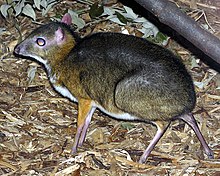Deer piglet
| Deer piglet | ||||||||||||
|---|---|---|---|---|---|---|---|---|---|---|---|---|

Kleinkantschil ( Tragulus javanicus ) |
||||||||||||
| Systematics | ||||||||||||
|
||||||||||||
| Scientific name | ||||||||||||
| Tragulidae | ||||||||||||
| Milne Edwards , 1864 |
Mouse deer or Zwergböckchen (Tragulidae) are a family of cloven-hoofed animals with a few species in the tropics of Africa and Asia . They are barely larger than hares and, historically, form the most primitive group of ruminants .
description
The body length of the deer piglets is between 40 and 85 cm, the weight between 2 and 12 kg, they are the smallest living cloven-hoofed animals . They have no forehead weapons, so neither horns nor antlers , but the canines , especially in the males, are enlarged and protrude like tusks from the mouth. The body is rounded; in contrast, the legs are very thin and appear fragile. Their coat color varies from orange-brown to gray and is lighter on the underside, usually whitish. In the genera Hyemoschus and Moschiola , the animals have white spots on their flanks arranged in strips .
The small head is characterized by the pointed snout and the relatively large eyes. The tooth formula of these animals is 0 / 3-1 / 1-3 / 3-3 / 3, so a total of 34 teeth. As with many other cloven-hoofed animals, the upper incisors are missing and the lower canines are similar to the incisors.
distribution and habitat
One species, the African stag piglet , is distributed in the central part of Africa, the other species, the Kantschile, live in South and Southeast Asia from India to Indonesia . Their habitat is mostly forests with dense undergrowth, predominantly rainforests , mostly in the vicinity of water.
Way of life
All deer piglets are crepuscular and nocturnal. They are very shy and withdrawn animals that you can hardly see. They are territorial animals that mark their territory with urine, feces or the secretion of a gland on the lower jaw. They either live solitary or in monogamous couples. Territories of solitary animals of different sexes can easily overlap. Outside the mating season, same-sex conspecifics respect the boundaries, only in connection with reproduction males have short fights in which they run towards each other and bite their canines.
nutrition
Deer piglets are predominantly herbivores, but are not particularly specialized in food: they eat leaves, grass, buds and fallen fruit. Animal diet (for example, insects, fish and carrion) makes up a small part of their diet.
Like all ruminants, they have a multi-chambered stomach .
Reproduction
A special feature that has been observed in at least two species is that the females often mate again only a few hours after birth and can thus spend almost their entire adult life in pregnancy. The gestation period is around five to seven months, and the litter size is usually one (rarely two). The young animals flee the nest and become sexually mature within a few months.
Systematics
|
Internal systematics of the Tragulidae according to Sarvani et al. 2018
|
Phylogenetically, the deer piglets are at the base of the ruminants and form the sister taxon of all other representatives of this group, which are summarized as Pecora (forehead weapon bearers). (See also the systematics of the artifacts .)
The earliest finds of ancestors of the stag piglets go back to the late Oligocene and the early Miocene . At that time, this relatively primitive group was also most widespread; it is known from Europe , Asia and Africa . Since then, their representatives have remained almost unchanged.
The following types are known:
- Genus Hyemoschus
- Genus Tragulus
- Greater mouse-deer ( Tragulus Napu )
- Java Kantschil ( Tragulus javanicus )
- Vietnam Kantschil ( Tragulus versicolor )
- Thailand Kantschil ( Tragulus williamsoni )
- Kleinkantschil ( Tragulus kanchil )
- Balabac-Kantschil ( Tragulus nigricans )
-
Fleckenkantschile (genus Moschiola , sometimes counted as tragulus )
- India Kantschil ( Moschiola indica )
- Ceylon-Kantschil ( Moschiola meminna )
- Yellow stripe square ( Moschiola kathygre )
The Asian stag piglets are also known as Kantschile. Some phylogenetic analyzes, based on anatomical features, identified them as a monophyletic group with the African stag piglet as a sister form . Molecular genetic studies from 2018 show that the representatives of the genus Tragulus are closer to the African stag piglet than to the spotted squirrel.
literature
- Ronald M. Nowak: Walker's Mammals of the World . Johns Hopkins University Press, 1999, ISBN 0-8018-5789-9 .
- David W. McDonald (Ed.): The Encyclopedia of Mammals. Oxford University Press, 2009, ISBN 978-0-19-956799-7 , pp. 722-723. (engl.)
Individual evidence
- ↑ a b Rama K. Sarvani, Drashti R. Parmar, Wajeeda Tabasum, Neelima Thota, Ara Sreenivas and Ajay Gaur: Characterization of the complete mitogenome of Indian Mouse Deer, Moschiola indica (Artiodactyla: Tragulidae) and its evolutionary signifcance. Scientific Reports 8, 2018, p. 2697 doi: 10.1038 / s41598-018-20946-5
- ↑ To Nguyen, Van Bang Tran, Duc Minh Hoang, Thi Anh Minh Nguyen, Dinh Thang Nguyen, Van Tiep Tran, Barney Long, Erik Meijaard, Jeff Holland, Andreas Wilting and Andrew Tilker: Camera-trap evidence that the silver-backed chevrotain Tragulus versicolor remains in the wild in Vietnam. Nature Ecology & Evolution, 2019, doi: 10.1038 / s41559-019-1027-7
- ↑ Manuel Hernández Fernández and Elisabeth S. Vrba: A complete estimate of the phylogenetic relationships in Ruminantia: a dated species-level supertree of the extant ruminants. Biological Reviews 80, 2005, pp. 269-302

